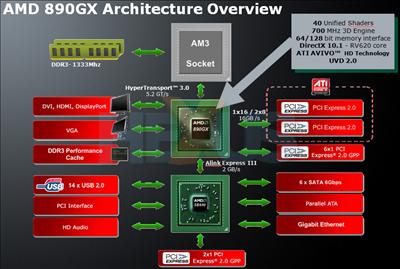The first of AMD's 8-series chipsets
Before we take a look at the ASUS board, let's find out exactly what AMD's 890GX chipset has in store.
Starting with the block diagram, we can instantly determine that 890GX - despite its massive jump in nomenclature - is an evolutionary step from 785G.
We don't expect AMD to integrate the northbridge and southbridge into a single-chip solution until perhaps the introduction of 900-series boards, and with northbridge and southbridge components remaining detached, 890GX brings with it a wave of improvements across the board (ed. pun intended?).
As expected, 890GX features an AM3 socket supporting AMD's latest Phenom II processors and your choice of DDR3 memory. What's interesting is that AMD's successor to Dragon - the Leo platform - is now two thirds complete. Leo consists of an 800-series chipset (a la the 890GX), Radeon HD 5800-series graphics and a hexa-core Phenom II X6 processor codenamed "Thuban". The latter is rumoured to be landing at the end of April as the final part of the high-end Leo jigsaw.
The new-and-improved 890GX IGP (northbridge) takes things up a notch from 785G with a quicker graphics core - albeit still based on the Radeon 4000-series line. There's currently no indication of when we'll see the first Radeon 5000-series integrated parts, but the 890GX IGP - now dubbed the Radeon HD 4290 - brings a few other enhancements to the table, too.
The chip is now partnered with a SidePort on-board frame buffer as standard, and 16 PCIe lanes that can support a single discrete GPU at x16 or dual-GPUs in CrossFire configuration at x8, x8. Really, then, it's more akin to the 790GX chipset.
The below table highlights the performance benefits over previous-generation AMD IGPs, as well as a comparison with Intel's latest.
| Chipset | AMD 890GX | AMD 785G | AMD 780G | AMD 790GX | Intel H55 | Intel G45 |
|---|---|---|---|---|---|---|
| Manufacturing process | 55nm | 55nm | 55nm | 55nm | 45nm | 65nm |
| CPU support | AMD AM3 | AMD AM2/AM2+/AM3 | AMD AM2/AM2+ | AMD AM2/AM2+/AM3 | Intel LGA 1156 | Intel LGA775 |
| IGP core | Radeon HD 4290 | Radeon HD 4200 | Radeon HD 3200 | Radeon HD 3300 | GMA HD | X4500 HD |
| DirectX support | 10.1 | 10.1 | 10 | 10 | 10 | 10 |
| GPU clock speed (MHz) | 700 | 500 | 500 | 700 | 900 | 800 |
| Shaders | 40 | 40 | 40 | 40 | 12 | 10 |
| GFLOPs | 56 | 40 | 40 | 56 | 32 | 24 |
| Memory type | DDR3 | DDR2/DDR3 | DDR2 | DDR2/DDR3 | DDR3 | DDR2/DDR3 |
| Video-processing tech | AVIVO HD (UVD 2.0) | AVIVO HD (UVD 2.0) | AVIVO HD (UVD 1.0) | AVIVO HD (UVD 1.0) | ClearVideo HD | ClearVideo HD |
| Blu-ray PiP support (Profile 1.1) | Yes | Yes | No | No | Yes | Yes |
| Native output support | DVI, VGA, DisplayPort, HDMI (v1.3) | DVI, VGA, DisplayPort, HDMI (v1.3) | DVI, VGA, DisplayPort, HDMI (v1.2) | DVI, VGA, DisplayPort, HDMI (v1.3) | DVI, VGA, DisplayPort, HDMI (v1.3) | DVI, VGA, DisplayPort, HDMI |
| Hybrid GPU support | Yes | Yes | Yes (no CF for discrete cards) | Yes | No | No |
The Radeon HD 4290 IGP is AMD's best to date, but it's worth noting that Intel's GMA HD is no slouch. For media use, most modern IGPs offer features such as simultaneous video acceleration and hardware upscaling, leaving little to choose between them in terms of day-to-day media use. AMD's solution is, of course, the most powerful, but in gaming terms even the Radeon HD 4290 is a distant second to basic discrete graphics card.
Unfortunately, like 7-series chipsets before it, 890GX offers support for only two-channel LPCM audio. A deal-breaker for the HTPC enthusiast, perhaps.
Once again, evolutionary as opposed to revolutionary, but arguably the chipset's most important enhancements lie further down the block diagram, with the new SB850 southbridge. Now connected to the northbridge via an all-new 2GB/s A-Link Express III interface, there's enough bandwidth on hand to feed a bevy of expansion options. Six SATA 6Gbps interfaces feature as standard, as does Gigabit Ethernet, and there's ample bandwidth for board manufacturers to implement USB 3.0 via a third-party controller.
AMD is quick to point out - and rightfully so - that Intel's rival H55 and H57 chipsets can run into bandwidth constraints when hooked up to SATA 6Gbps and USB 3.0 controllers.
It's a feature-packed combination, and with AMD having no answer to Intel's Nehalem in the ultra-high-end performance stakes, it continues to battle it out in the mid-range space with products that offer plenty of bang for buck. An 890GX motherboard, coupled with say a 3.4GHz quad-core Phenom II processor, 4GB of DDR3 memory and a Radeon HD 5000-series discrete graphics card makes for a potent mix at around the £400 mark.










